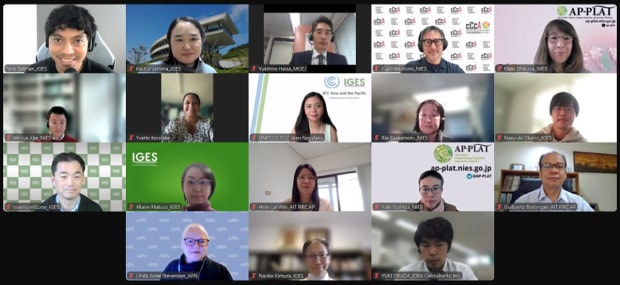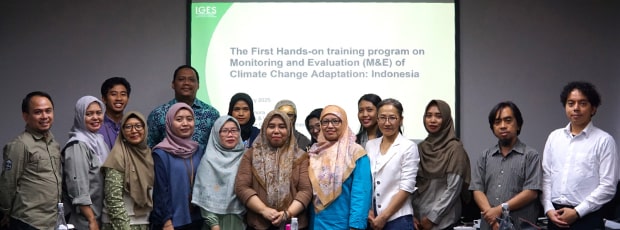  |

The 6th Issue: 20 March 2025 |
 |
Greetings from the Asia-Pacific Climate Change Adaptation Information Platform (AP-PLAT)!
As we move forward in 2025, AP-PLAT continues to strengthen climate adaptation efforts across the Asia-Pacific through key capacity-building programmes and regional collaborations. This March 2025 issue of our newsletter highlights recent milestones, including the 3rd AP-PLAT Regular Meeting on Capacity Development, hands-on training sessions on adaptation monitoring and evaluation (M&E) in Thailand and Indonesia, and capacity-building workshops and field consultations in Bangladesh and Nepal. We also introduce the H08 Water Risk Tool, which supports water risk assessment and adaptation planning related to water issues.
Additionally, this issue features partner-led initiatives, such as climate vulnerability assessments in Mongolia and China, and waste management and resilience efforts in the Pacific island region.
For more, visit https://ap-plat.nies.go.jp/index.html. |
1. AP-PLAT’s Activities and Updates |
|
The 3rd AP-PLAT Regular Meeting on Capacity Development was held online on 27 January, 2025, and brought together partner organisations to advance the AP-PLAT Three-Year Action Plan. Key discussions covered discussions on future collaboration among the partners, and planned updates to the AP-PLAT website. The planned updates include a support tool and website for Green Climate Fund (GCF) proposal development and ClimoCast Pro.
 |
|
The Institute for Global Environmental Strategies (IGES) and the Department of Disaster Management of Bangladesh, supported by the Ministry of Environment. Japan (MOEJ), conducted field consultations in Sirajganj District under the AP-PLAT Capacity Development Programme to assess early warning systems and necessary interventions. A co-development workshop in Dhaka will further integrate technical insights and local experiences to develop a localised disaster management framework.
 |
|
As part of efforts to enhance resilience to compounding and cascading disaster risks (CCDR) in Nepal, IGES, with support from the MOEJ, collaborated with the Center of Research for Environment Energy and Water (CREEW) and the Center for Water Resources Studies Institute of Engineering, Tribhuvan University (CWRS) to facilitate a capacity-building workshop for project development.
 |
2. Introduction to AP-PLAT deliverables and achievements |
|
AP-PLAT continues to play a key role in advancing climate adaptation efforts across the region. As part of Japan’s bilateral cooperation with Thailand, AP-PLAT served as a reference for the development of the Thailand Climate Change Adaptation Information Platform (T-PLAT). T-PLAT was designed to align with AP-PLAT’s objectives—enhancing climate risk data access and supporting regional knowledge-sharing. |
|
The second hands-on training on adaptation M&E in Thailand, held on 14 January, 2025, was a continuation of the first training in October 2024, which introduced the Japan Adaptation Monitoring & Evaluation System (JAMES) on AP-PLAT. This session focused on challenges in Thailand’s adaptation Monitoring & Evaluation (M&E), including the incomplete national adaptation action plan, lack of KPIs, and weak data collection systems.
 |
|
Hands-on training on adaptation M&E in Indonesia was held on 3-4 February, 2025, and introduced JAMES on AP-PLAT. Participants engaged in an interactive exercise using the JAMES scorecard, identifying knowledge gaps in Indonesia’s NAP (National Adaptation Plan) process and discussing differences between JAMES, Indonesia’s National Climate Change Registry (SRN) and Vulnerability Index Information System (SIDIK).
 |
Introduction of tools on AP-PLAT: Water Risk Tool
The H08 Water Risk Tool developed by NIES is a global water risk assessment tool based on the H08 hydrological model. The tool identifies key causes of future water shortages, such as decreasing rainfall or rising water demand. The tool can support policymaking and adaptation planning by identifying water stress drivers and water scarcity indicators, as well as providing insights for water management strategies.
 |
3. Activities and updates from our partners |
Beyond AP-PLAT’s activities and deliverables, organisations across the region are advancing their own adaptation efforts. This section highlights climate vulnerability assessments in Mongolia and China, and waste management and resilience efforts in the Pacific island region. |
|
A collaborative project in Mongolia and China is working to strengthen local adaptation plans by integrating socio-economic vulnerability assessments and policy gap analysis. Led by the Mongolian Academy of Sciences, this project collaborates with several other research institutes such as Chinese Academy of Sciences, Nagoya University, National University of Mongolia, Climate Change and Development Academy of Mongolia, and the Information and Research Institute of Meteorology, Hydrology and Environment, Mongolia. One of the project initiatives evaluates the climate vulnerability of the herder-livestock-pasture system in Khovd Province, Mongolia, and Ulaanqab Prefecture, Inner Mongolia, China. Researchers analyse key climate change vulnerability indicators and assess local climate adaptation policies based on national frameworks. The findings will provide region-specific policy recommendations to support local governments. |
|
The Pacific Climate Change Centre (PCCC) was featured in the JICA Clean City Initiative (JCCI) international discussions, highlighting its collaboration with JICA on climate resilience and waste management in Oceania. The event showcased the PCCC E-learning Platform, which has trained over 500 professionals, and the success of the JICA-funded Capacity Building on Climate Resilience project (2019–2023). Discussions also highlighted the J-PRISM project, supporting solid waste management through the 3R + Return concept. |
|
The NAP Global Network (NAP GN) released its latest publication. NAP GN investigates countries’ NAP and NDC documents submitted to the UNFCC’s NAP Central platform and the briefing note outlines key trends that could help us understand how well adaptation information is aligned in these complementary processes. Countries are scheduled to update their nationally determined contributions (NDCs) early this year, making 2025 a strategic time to leverage NAP processes for adaptation in their next NDCs. |
4. Call for your contributions to the AP-PLAT newsletter |
We invite partner organisations and stakeholders to actively participate in AP-PLAT activities to strengthen our network and expand access to adaptation knowledge. By sharing your updates and initiatives, you can help shape adaptation strategies and inspire meaningful action. Contributing your events, updates or announcements through our newsletter allows you to reach over 30 partner organisations and more than 20 independent subscribers from other climate adaptation platforms, research institutes, the private sector, governmental agencies, and other stakeholders that are actively involved in climate adaptation initiatives.
To share your information with our community, please contact the AP-PLAT secretariat at [ap-plat@iges.or.jp]. |
5. Want to become a member? |
If you are interested in becoming a supporting organisation and/or capacity development partner organisation, please apply using the following links.
|
Please spread the word! |
If you know anyone who would be interested in AP-PLAT, please forward this newsletter to them and spread the word about AP-PLAT through your community. You can subscribe from this link. |
|
 |
|